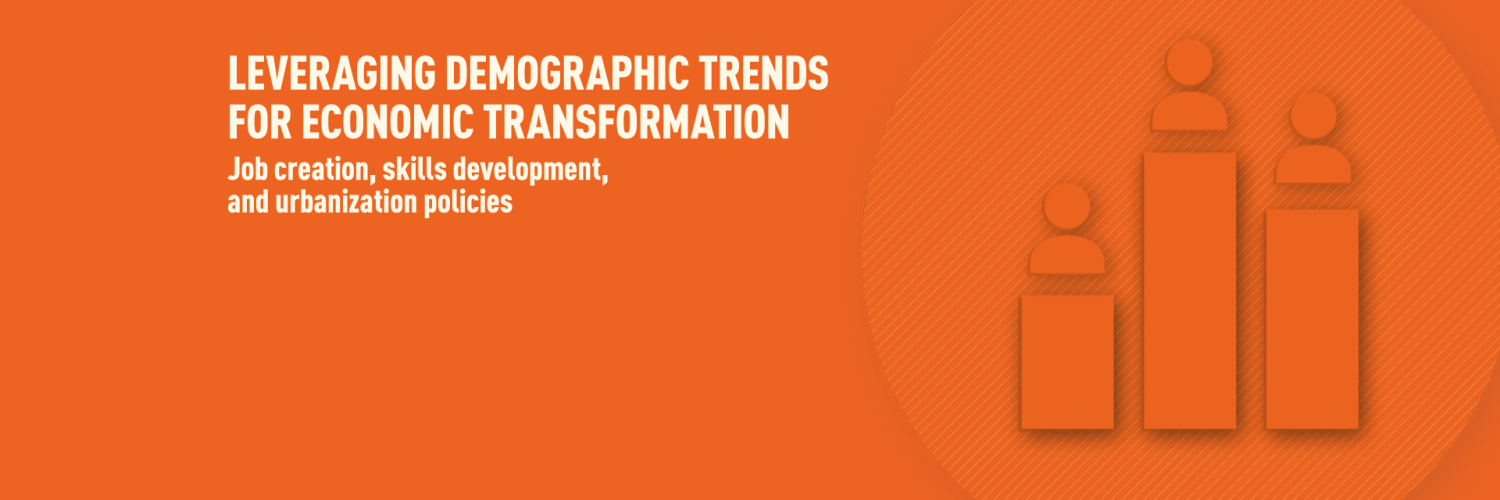Below is Chapter 3 of the Foresight Africa 2020 report, which explores six overarching themes that provide opportunities for Africa to overcome its obstacles and spur inclusive growth. Download the paper to see the contributing viewpoints from high-level policymakers and other Africa experts.

Structural change is taking place in Africa, but with a pattern that is distinct from the historical experience of industrialized countries and contemporary East Asia. Export-led manufacturing is playing a much smaller role in the structural transformation of Africa’s economies. In fact, on average, the share of manufacturing in Africa’s GDP has fallen since 1980. Instead, services—some with quite low productivity—absorb the bulk of African workers leaving agriculture and moving to cities. These changes reflect the impact of technological progress, a changing global marketplace, and natural resource endowments on Africa’s industrialization prospects.
At the same time, reductions in transport costs and progress in information and communications technology (ICT) have created services and agri-businesses that share firm characteristics with manufacturing.1 Like manufacturing, they are tradable and have high value added per worker. They have the capacity for learning and productivity growth, and some exhibit scale and agglomeration economies.2 Importantly, between 1998 and 2015, services exports grew more than six times faster than merchandise exports across Africa.3 Notably, firm capabilities—the tacit knowledge and working practices embodied in the firm—play a central role in determining productivity and quality. For lack of a better term, we call these “industries without smokestacks” (IWOSS) to distinguish them from traditional, “smokestacks” industries. We define IWOSS activities as those that (i) are tradable; (ii) have high value added per worker relative to average economy-wide productivity, as well as exhibit capacity for technological change and productivity growth; and (iii) can absorb large numbers of moderately skilled labor. In addition, IWOSS sectors show some evidence of scale or agglomeration economies.
A number of these IWOSS have become increasingly important in Africa, including agro-industry and horticulture, tourism, some business services—including ICT-based services—and transport and logistics.4
Does the growth of industries without smokestacks offer an opportunity to address the youth unemployment challenge? Early lessons from South Africa.
To examine this question, the Africa Growth Initiative at Brookings has initiated a multi-year project to assess the employment creation potential of IWOSS in Africa. In what follows, we present the early findings from the South Africa pilot case study.
South Africa has been in a low-growth trap since the onset of democratic rule in 1994. Between 1994 and 2017, real GDP per capita grew at an average rate of only 1 percent per year. As a result, the country has achieved only modest reductions in household poverty levels, coupled with high and rising inequality.
The labor market is a primary driver of inequality, as there are a significant number of zero earners in the income distribution, marked prominently by high youth unemployment rates. South Africa’s youth unemployment rate—at close to 55 percent in 2018—is considerably higher than comparable upper-middle- income countries or other countries in sub-Saharan Africa. As is the case with overall unemployment, youth unemployment in South Africa has also been on a clear upward trend since 2008.
Like in many countries across Africa, South Africa’s current growth path has failed to provide sufficient jobs for the low-skilled unemployed.5 The post-apartheid South African economy has been characterized by an eroding primary sector and a stagnant manufacturing sector—a concerning trend (Figure 3.2). Instead, there has been a shift toward services sectors, with finance, transport, construction, and other services experiencing employment growth. Notably, the financial and community services sectors have accounted for over half of the increase in employment between 2000 and 2019.
This shift toward services without manufacturing growth is characteristic of much of Africa. But South Africa is an outlier among other African countries. Elsewhere in Africa, the shift toward services has been largely characterized by a shift into low-productivity services, often in the informal sector. In South Africa, financial and community services are relatively high-productivity sectors. At the same time, though, the shift towards formal sector services has not generated the volume and type of jobs needed to reduce unemployment and inequality. In short, while the shift to services may offer South Africa an opportunity for the type of structural transformation previously anchored by growth in manufacturing, this achievement depends, importantly, on the type of services.
Of the 8.9 million formal private sector jobs in South Africa in 2019, IWOSS sectors account for over two-thirds (68 percent), over double the share of non-IWOSS sectors (Figure 3.3).
The largest employing IWOSS sectors are financial and business services (23 percent of IWOSS employment) and trade (16 percent). Tourism accounts for 9 percent of IWOSS employment in the formal private sector.
In the absence of growth in the manufacturing sector, then, South Africa already appears to be on a path of structural transformation characterized by a shift toward industries without smokestacks. Within the broader IWOSS category, there are a number of subsectors that may be better suited to address South Africa’s employment challenges. Although the skills distribution of employment in IWOSS and non-IWOSS sectors is broadly similar, scaling up a number of IWOSS activities that are more labor intensive may offer better opportunities for a labor force that is predominantly low- and semi-skilled.
Notably, the share of high-skilled employment is lowest in IWOSS sectors—under 10 percent in agro-processing, horticulture, and other commercial agriculture (Figure 3.4). The share of semi-skilled employment is similar across sectors at around 65 percent, and the share of low-skilled and semi-skilled employment (combined) is higher for IWOSS—most acutely in tourism, horticulture, and agro-processing (greater than 90 percent of all employment). Thus, these sectors have the potential to generate employment for the low-skilled labor force on a large scale, if the operating scale of these sectors can be increased. Of course, growing the IWOSS sectors requires addressing constraints to unlock their potential.
Realizing the potential: Some policy lessons
The objective of our research is to widen the options for structural change and job growth in Africa. Notably, efforts to grow IWOSS can have similar or better outcomes on employment as efforts to expand manufacturing in South Africa, as IWOSS sectors are more labor-intensive than manufacturing and the economy overall (Figure 3.3).6 Indeed, projections from our preliminary results indicate that, over the next decade or so, IWOSS sectors can generate three and half times more new formal sector jobs than non- IWOSS sectors.7
Notably, efforts to expand IWOSS may have employment outcomes that are more inclusive than those achieved from increasing growth in manufacturing and other non-IWOSS sectors. In fact, IWOSS in South Africa seem to be more intensive in the employment of women and youth than non-IWOSS sectors (Figure 3.4). The tourism and agro-processing sectors are particularly intensive in the employment of women,8 while horticulture and tourism have the highest shares of individuals between the ages of 15 and 34 in employment. This tendency towards inclusivity is another reason governments should enact policies to support the development of these sectors.
Three areas of the investment climate are particularly relevant to industries without smokestacks and manufacturing— infrastructure, skills, and the regulatory environment.9
- Poor infrastructure, particularly electrical power and transport, is the largest constraint affecting firm productivity, hindering the development of any sector.10
- The inadequately skilled labor force is also a constraint. Nearly 60 percent of African 15- to 24-year-olds have only completed primary school, and only 19 percent have gone beyond lower secondary.11 In South Africa in particular, the share of the labor force aged between 15 and 34 with an educational level below secondary education is 46 percent.12 Skill shortages for South Africa are particularly high for basic skills such as reading comprehension, active listening, speaking, and writing.13 Monitoring, strategy learning, critical thinking, and active learning skills are also in great shortage in South Africa. While IWOSS presents opportunities for the employment of low-skilled individuals, without a concerted effort to address current skills gaps, the full potential of these sectors will not be realized.
- Because productivity in services has an important impact on productivity levels across the economy, enabling competition through regulatory reforms are essential. Removing barriers to foreign entry in services can increase competition, reduce costs, and extend access to a broader range of differentiated services.
For most countries in Africa, regional and global export markets represent the best opportunity for IWOSS. To offset the costs to first movers, African governments need to develop a package of trade and exchange rate policies, public investments, regulatory reforms, and institutional changes aimed at increasing the share of non-traditional exports in GDP—put differently, governments need to mount an East Asia-style “export push”
Like manufacturing, IWOSS sectors benefit from agglomeration, including thick labor markets, information and knowledge spillovers, and the ability to share overhead expenses and services. While most African governments have focused on using special economic zones (SEZs) to promote manufacturing, SEZs are relevant to services and agro-based industries as well.
By addressing these constraints to the growth of IWOSS and manufacturing, governments are not forced to choose between an “industrial policy” focused on manufacturing and policies to promote tradable services and high-value agriculture. Both can achieve structural change and job growth.
-
Footnotes
- See William Baumol, “Unbalanced Growth Revisited: Asymptotic Stagnancy and New Evidence,” American Economic Review 75, no. 4 (1985): 806-17 and Jagdish N. Bhagwati, “Splintering and Disembodiment of Services and Developing Nations,” The World Economy 7, 2 (1984): 133-44.
- Gunther Ebling and Norbert Janz, “Export and Innovation Activities in the German Service Sector: Empirical Evidence at the Firm Level,” ZEW Discussion Paper 99-53 (1999); Ejaz Ghani and Homi Kharas, “The Service Revolution,” World Bank Economic Premise 14 (2010).
- John Page, “Rethinking Africa’s Structural Transformation,” in Foresight Africa: Top Priorities for the Continent in 2018 (Washington, D.C.: Brookings Institution, 2018), 66-8.
- Richard Newfarmer, John Page, and Finn Tarp (eds.), Industries without Smokestacks: Industrialization in Africa Reconsidered (Oxford: Oxford University Press, 2018).
- Around half (48 percent) of the South African labor force in 2019 has not completed secondary schooling.
- The available data cannot be disaggregated to calculate IWOSS-specific measures of labor intensity. For this reason, broad sectors have been identified as sectors in which IWOSS are dominant. The measures of labor intensity have been calculated using the most recent available input-output tables for the year 2014 (see Statistics South Africa, Input-output tables for South Africa, 2013 and 2014 (Pretoria: Statistics South Africa, 2014)) in the case of the employment multipliers, and the most recent available GVA data for the year 2018 (see Statistics South Africa, GDP P0441, 2019Q2 (Pretoria: Statistics South Africa, 2019)) in the case of the labor-to-value added ratios. The labor-to-value added ratio is expressed in local currency (rand) in 2010 prices.
- Forthcoming AGI project on South Africa case study on employment creation potential of IWOSS.
- ICT also has a relatively high share of women of employment. However, ICT accounts for just 1 percent of all IWOSS employment.
- See Carol Newman et al., Made in Africa: Learning to Compete in Industry (Washington, D.C.: Brookings Institution Press, 2016) for a discussion of the investment climate.
- See, for example, Alvaro Escribano, J. Luis Guasch, and Jorge Pena, “Assessing the Impact of Infrastructure Quality on Firm Productivity in Africa: Cross-country Comparisons Based on Investment Climate Surveys from 1999-2005,” World Bank Policy Research Working Paper 5191 (2010).
- Deon Filmer and Louise Fox, Youth Employment in Sub-Saharan Africa (Washington, D.C.: World Bank, 2014).
- Statistics South Africa, Quarterly Labour Force Surveys (QLFS) (various years) (Pretoria: Statistics South Africa, 2019).
- “OECD Skills for Jobs Database,” OECD, accessed December 3, 2019.












